![]()
![]()
![]()
![]()
![]()
![]()
![]()
![]()
![]()
![]()
![]()
![]()
![]()
Archives & Museum Informatics
158 Lee Avenue
Toronto Ontario
M4E 2P3 Canada
ph: +1 416-691-2516
fx: +1 416-352-6025
info @ archimuse.com
www.archimuse.com
| |
Search A&MI |
Join
our Mailing List.
Privacy.
published: March 2004
analytic scripts updated:
October 28, 2010

Designing Collaborative Group Experience for Museums with Telebuddy
Anja Hoffmann and Stefan Goebel, Digital Storytelling, Germany
Abstract
In this paper we describe the Telebuddy project that aims to connect a live audience with an Internet community. Telebuddy is a physical avatar equipped with camera, microphone and speakers and connected to the Internet. Online users access the Telebuddy system via an Internet platform and communicate with people at remote places. With Telebuddy a novel user experience of feeling present at distant locations — feeling "tele-present" — can be achieved. Within a museum's environment several application scenarios are possible and will be discussed.
Keywords: Experience Design, Mobile Web Cam, Internet Chat, Tele-presence, Electronic Toys, Physical Avatars, Wearable Computers
Introduction
Nowadays museums are confronted with the demand to bring their exhibits into the Internet and to maintain online archives about their exhibition. The challenge here is to find a suitable form of presentation. The more traditional way is to show the exhibit with the help of photographs or images enhanced with textual information or to offer video clips about it. From a rational point of view it seems that all necessary information could be given that way. But from an emotional point of view there is a lack of holistic user experience, e.g.:
-
The user is restricted to the passive role of a spectator.
-
The user cannot experience the whole exhibit concept and the atmosphere.
Another possibility is to provide live video streams online. For the users, that could be more exciting and enjoyable because they get the atmosphere and have the impression of watching a live event. But there are still unsatisfying aspects concerning the online users' experience.
-
The users cannot influence the activities on-site.
- The users can watch the event but not participate.
To bridge this gap a system has been developed that combines Internet chat with live video streaming and a physical avatar — the Telebuddy (see Spierling/Dechau, 2000, Dechau et al. 2000, Dechau et al. 2001).
The Telebuddy project aims to connect a live audience in a museum's environment with an online community in the Internet. Telebuddy — a puppet or physical avatar - provides a visible body for the eyes and the ears of the Internet: The avatar resembles a real person who has the capability to see (through a camera), to hear (with a microphone) and to talk (through a speaker). Additionally, the puppet contains an infrared sensor to specify its position in a building. Like a "buddy", it can accompany a pedestrian visit to exhibitions or interesting locations, and can talk about the shared experience.
In cooperation between the Computer Graphics Center (ZGDV e.V.) and Fraunhofer Institute for Computer Graphics Rostock, the Telebuddy system has been developed as a prototype.
Motivation
Meeting and talking with other people is a natural desire of human beings. Phones enable calls to people all over the world. In the era of the Internet it is possible to meet at distant places without taking one step out the door. Chat and Web cams allow people to meet on the Internet. The desire for telecommunication is satisfied in many ways. In contrast, the desire of tele-presence is still unaccomplished. As Dechau et al. (2000) have defined, tele-presence is given when a person can take an active role at a distant location: the person is able to define content, influence the situation and other people and show verbal or nonverbal actions. From the viewpoint of an Internet user, one must have the impression of immersion, of being at a distant location. How?
The Internet user needs to ...
-
speak
- listen
-
see
-
move.
The metaphor was to have mouth, ears, eyes, hands and legs for the Internet. Therefore, the Telebuddy system has been designed and implemented.
Related Work
The work on Telebuddy has been inspired by a number of existing communication and information systems; e.g. Web cams, Internet chat or electronic toys. All of these systems have their advantages and constraints as described in the following paragraphs:
Web cameras
Web cams provide live video streams of exhibits and events. The user gets — in comparison to single pictures and text - additional information about ambient conditions (e.g. soundscape and light,...), visitors (e.g. number of visitors, behaviour,...) and environment (e.g. museum's building, interior decoration,...). Nowadays developments in streaming technology enable good quality visual and audiovisual information. Live video streams can be stored and archived. With that, a museum's visitor service is enhanced.
Web cam technology opens a wide market - from private usage up to the area of security applications and appliances. Indeed, there is also a wide field of misuse that makes users feel suspicious of the technology. The interaction is limited to start and stop the movie or change the point of view. Active participation from the Internet user's site is possible.
Internet Chat Systems
The combination of Internet chat systems and multi-user applications allows online users — represented by avatars — to meet and talk in virtual 3D worlds. Examples are Virtual Fairs where people meet at a trade booth, or job fairs where applicants could get in contact with companies and employers. Linked with live video streaming via Web cams, users in the chat room could refer to ongoing activities at the distant place, but communication with people on-site is not possible.
Electronic Toys
Computer-based toys have an important role in the entertainment industry. The well-known Teddy bear has become intelligent and interactive. Examples are Microsoft Actimates™(http://www.microsoft.com/hardware/actimates/) or Furby™. Apart from entertainment purposes, E-Toys also step into other application fields. The Leonie project of Siemens provides a security system hidden in a puppet or Teddy bear (see http://www.siemens.com). Pushing a secret button sends an emergency call and the position of the child will be tracked by GPS (Global Positioning System). These toys are designed to save children in emergencies because mailbox messages like "The person you've called is not available" are intolerable in these situations.
User Interface And System Achitecture
The innovative character of Telebuddy lies in the successful combination of the advantages of all three areas mentioned above: Telebuddy enables remote participation at live events and establishes communication between online users and people on-site.
Physical Interface
The physical avatar as a link to the virtual world has to fulfil several intentions.
-
it is a high-tech wearable computer equipped with camera, microphone, speakers and robotics.
-
it is the representative of Internet users. Therefore, a concept for its visual appearance was essential. Instead of "looking through a keyhole" (e.g. like an observation cameras) it should be obvious for the people on the spot if there is anybody else who looked at them. In addition, its functionality should be apparent as well. So, the physical avatar has: - ears because he can hear (with a microphone);- eyes because he can see (with a camera); - a mouth because he can speak (through a speaker); and hands because he can lift his hand to get attention (with the help of robotics).
- Nevertheless, the avatar has no legs. To avoid being tied to
a stationary setting, any person can carry the avatar like a backpack.
the puppet helps to overcome one's inhibitions to "talk" to a technical system. Only a few people would talk to a camera, but a lot would talk to "something" cute and playful. That effect makes it more enjoyable for the users in the Internet, who will have a representative at the distant location.
-
for a museum, company or event organizer it could be considered as a marketing instrument that attracts attention. It could look like the mascot or — concerning a museum or art exhibit — as a well-known artist or artefact. It is enjoyable for the visitors at the museum interacting with the "living puppet", and it makes their visit more interesting.
Web Interface
The Telebuddy Web interface reflects interactions by combining chat systems with Web cameras and electronic toys. Nevertheless, regarding the playful character of the physical avatar and the target group (e.g. museums visitors, children, elderly people), the Internet application must be intuitive to use. The platform is created for Internet users with different levels of knowledge about computers and technologies, such as Internet chat rooms or other community platforms. The user group consists of both chat experts who expect a certain system behaviour and users who rarely surf the Internet and have never visited a chat room before.
Internet users access the platform through a Web portal (http://www.telebuddy.de). The interface is then divided into two main parts: an informational space and an interaction space. The information space provides an integrated video window for live video streaming and audio transmission. Additionally, textual and visual information about the museum, exhibition and exhibits is available where users can simply browse through. An online archive of past events may also be included.
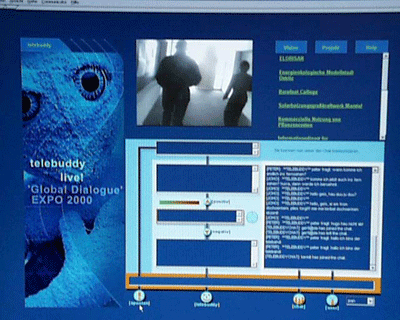
Figure 1 : Telebuddy Web interface
Basically, the interaction panel - based on a Java applet - consists of four modules: chat room, question stack, spontaneous messaging system and Telebuddy emotion features.
The chat room supports communication from user to chat group, from user to single user and from user to Telebuddy. In the last case, the message is transmitted to a text-to-speech converter and forwarded to the Telebuddy speech output (microphone).
To initiate a common ground within the Internet community, a question stack with voting system was established. Any message generated by a single user and send to Telebuddy is judged by the other users to avoid insults and defamations. Contributions with high ratings move to the top of the stack.
For spontaneous messages there is an additional functionality implemented. The messages are sent directly the Telebuddy.
The Telebuddy emotion features allow users to show rudimentary emotional expressions. With their message they can send emotional annotations that are presented by Telebuddy's facial expressions, giving feedback through the avatar.
System Architecture
The system architecture of the Telebuddy project is built upon a local server for wireless connection management between the avatar and the Internet and a main server providing data. The two-server architecture guarantees communication between the physical avatar as a mobile component and the client interaction applet on the Internet user's browser. The avatar is permanently connected to the local server via wireless analogue radio. With only one base station, a field of 400 meters inside buildings can be covered because of two analogue channels using the 2.4 GHz and 433 MHz frequency band (see Spierling et al. 2000).
Designing User Experience
All possible scenarios provide a unique collaborative user experience. It gives people the illusion of being present at the same place and taking an active role in the scenario. To describe the overall user experience, it is useful to clearly define characteristics of experience design.
Usability and User Experience Goals
Preece et al. (2002) differentiate between usability goals and experience goals. The achievement of usability goals is widely accepted in (computer-based) system design. There is almost a common understanding that appliances and applications have to be, efficient and effective to use
-
easy to learn and to remember how to use
-
safe to use.
Primarily, these goals concern the improvement of efficiency and productivity (at work). Less clearly defined are criteria regarding the users' subjective feelings while interacting with systems. Experience goals deal with the following question from a user's perspective: Is the system and interaction with the system,
- fun
- emotionally fulfilling
-
rewarding
- aesthetically pleasing
- entertaining?
Storytelling to Enhance User Experience
Mainly, entertainment and computer games industries contribute to the work on enjoyment and fun. Braun et al. (2002) found that computer games primarily get their entertaining character and dramatic nature out of the game play and the risk of losing the game. Stories, in opposition to games, provide dramatic structures, offer activities and plots, and cause the manipulation of space and time in the users' minds (see Laurel, 1993). Therefore, the telling of stories contributes to the experience goals.
Regarding collaborative aspects, the group experience lies in generating, narrating and listening conjointly to a story, so-called Computer Supported Collaborative Storytelling (see Braun et al., 2002):
The collaboration could be between person-person or person-virtual character. Examples are listed in the following points:
-
Persons that use stories to narrate information from one to another (e.g. decontextualisation of information)
-
Persons that use stories to get a common context of information.
-
Persons that create a story together (e.g. so called Web stories)
-
Persons narrating a story together.
-
Persons experiencing a story together, for example by playing several roles within a story or by listening together to a narration."
-
Telebuddy — the physical avatar and virtual character — takes two
-
Telebuddy as part of the (virtual) audience.
-
Telebuddy as virtual narrator.
For museums both constellations are interesting. The following paragraph specifies the thinkable scenarios.
Social Presence Aspects
To fulfil humans' desire to meet at distant places in the era of telecommunication and the Internet is mainly supported by videoconferencing and Internet chat systems. As addressed in social presence theory (Short et al., 1976), the sense of being present at a distant location depends on verbal and nonverbal cues, body language, context, facial expression, and appearance that affects emotion intimacy and immediacy (see Preece 2000 and Rice, 1987, 1993).
In comparison to videoconferencing, Telebuddy takes one-step forward: it is highly visible, tangible and audible. In addition, it conveys rudimentary facial expressions. For the visitors at the museum, the Internet users are represented in a highly extraordinary, emotive way that affects the online community in turn.
Tests with the Telebuddy system have demonstrated that the puppet is recognized as something lively and animated. As soon as Telebuddy has shown its ability to speak, people feel free to talk to him. They have an intense interest to find out whether there is a machine or a person behind it. Again, these efforts are exciting for online users as well and help to establish vivid communication.

Figure 2 : First puppet prototypes
The visual appearance of the puppet is an important criterion for people's communication attitude. For instance, a dangerous looking Telebuddy would cause more reserved communication behaviour than a friendly-looking puppet.
Setting The Scene
Initially, the Telebuddy was designed for the International World Fair EXPO at Hannover/Germany in 2000. The usage scenario was to establish communication between an online community and EXPO visitors.

Figure 3 : Telebuddy and visitors at EXPO

Figure 4 : Telebuddy at an EXPO exhibition booth
At the same time, two other research institutes opened their doors for Telebuddy. All events could have been followed in the Internet. Anyhow, any events, exhibitions or occasions with highly entertaining characters are possible application fields for Telebuddy.
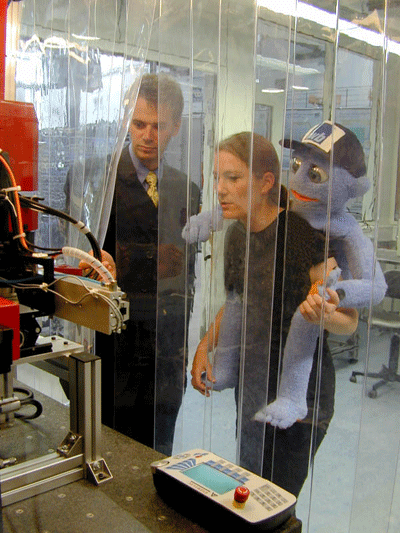
Figure 5 : Telebuddy at a German research institute
Story Space in Museums
The degree of freedom of a story ranges from emergent to predefined. Emergent means that the story is generated while the system is used and the users are in interaction with each other. In contrast, a predefined story is narrated exactly how it is written by an author. The museum where the Telebuddy system is applied can be seen as an author who defines content, actors, props and story line.
Content
The purpose of a museum is to entertain, to inspire and — primarily — to present artefacts. Therefore, the content of a museum is mostly predefined. Telebuddy can be easily integrated in an existing exhibition concept.
Narrator, Moderator and Auditors
Both online and on-site visitors to the museum can play active roles in the whole scenario. The person who carries the Telebuddy takes an important part. He is the one who influences the whole story with his behaviour. The user experience — especially for the online community - depends on his cooperation: he must turn into an appropriate direction to assure acceptable video quality. With an integrated display in Telebuddy's hand, he can control the submitted video image
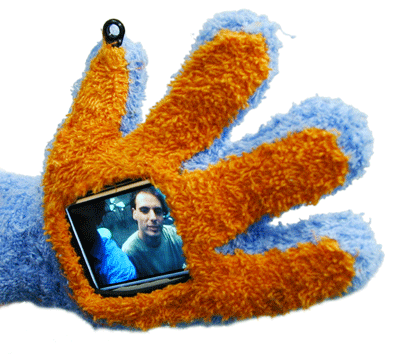
Figure 6 : Integrated display
Furthermore he controls the flow of the story. By giving an outlook to the next scene (e.g. the next exhibit or artefact) he influences suspense and dramatic structure of the story.
Especially in Web environments the retention period lasts only a few seconds if nothing interesting and spectacular happens. A moderator needs to control and generate communication and story. Additional tasks of the moderator include facilitating, keeping the group focused, opening questions and reducing flaming (see Preece 2000). The level of activity of the moderator depends on the story concept. In an emergent story, the role of the moderator can be limited to help people with general needs. The moderator can be part of the online community, on site at the museum, or the person who carries the puppet.
It is important to distinguish the role of a moderator from that of the narrator because it is not always the same. Mainly, the narrator is responsible for presenting content and story plot. Any person in the different settings could step into the role of the narrator: people online, visitors in the museum or the carrier of Telebuddy himself. Positions can also change during the ongoing story: online user(s) start the story and can be displaced by visitors in the exhibition. The role of Telebuddy also changes: in the first case the puppet is the physical representative of the Internet community and therefore, it is the narrator. Telebuddy can be seen as a spectator when he is listening to a story that is told by the people in the museum.
Story Plot
As mentioned above, the degree of freedom of the story ranges from a predefined story plot to an emergent structure. The two extreme situations are described in the following:
1. Predefined story
-
Planned story flow, actors, content and dialogues
-
Story is defined by an author who is responsible
-
Planned suspense, surprise and dramatic structure
-
Spectators can watch, listen and act within limits
-
Similar to theatre and movie plots
-
Story is repeatable
2. Emergent story
-
Actors, content and dialogues depend on the actual situation
-
Author defines the framework but cannot influence the ongoing story; he cannot preview the end result
-
All persons in the scenario can take an active role — highly interactive
-
Story is unique
-
In museums, either both scenarios or something in-between are interesting and possible.
Application Scenarios
Telebuddy is interesting for the areas of both art and science. Concerning museum specific aspects, the following user scenarios are interesting:
Artists or experts in the museum
A unique form of art and science presentation is given with Telebuddy - for instance, when a museum has invited a well-known artist or expert:
Artists present their own artwork from their specific point of view. They could explain what they intended to express, what they think about and how they realized the artwork.
Experts from the science or art area could hold expert panels to enhance the exhibition, initiate a lively discussion and answer certain questions.
The sessions will be streamed to the Internet via Telebuddy. In opposite to Web cam applications, the online users could get into interaction with the experts on-site. They could ask the artists/experts directly although they are situated at a distant location, and get an impression of personal motives and thoughts of the artists/experts. Visitors either on the museum's site or at far locations have the chance to participate in his special event.
Artists or experts as part of the online community.
Known artists and experts mostly have a tight schedule and little time to travel to any places, especially when they come from all over the world. By using the Telebuddy system they could be in touch with visitors from distant places as often as they want — without time-consuming traveling. They will be represented through the physical avatar, though visitors on-site have a contact "person" to answer their questions and to establish an interesting discussion. It's interesting for artists as well to get in touch with visitors and art admirers. They will learn about the visitors' point of view and opinions.
Online visitors meet with visitors at the museum
Both users from the Web and people on-site could experience the exhibition together and share their impressions. The online community could ask the person who carries the puppet to improve their viewpoint, e.g. to get closer or to turn around. In return, the Internet community can provide the visitors on-site with additional information on the online platform — a novel form of collaboration.
Future Work
As mentioned above, Telebuddy is a new medium for working and learning collaboratively. For edutainment purposes, a treasure hunt scenario called Dino Hunter will be build upon the Telebuddy system (see Feix et al., 2003 and Goebel/Sauer, 2003). Dino Hunter is a virtual rally application that connects real and virtual worlds and maintains collaboration between online users and visitors on-site. The system is applied to the scientific field of palaeontology. An example scenario is described below:
A group of pupils have to build up a virtual dinosaur from petrified bones and teeth. Starting from a central so-called "Base Camp" — a stationary kiosk system connected to the Internet - the group receives the instructions for the puzzle. Then they divide into subgroups with members online and in the museum to start the rally. The online participants get different information from what the kids at the museums have; e.g. they get a map and location-based information. The children at the museum have to accomplish all the operations a real palaeontologist usually does; e.g. searching for bone-fragments, uncovering, collecting, preparing and bringing the bones to the Base Camp (collecting point) and reconstructing the whole skeleton. For finding the bone fragments and solving small additional tasks, they need the hints of the Internet community. The interesting point is that the group members have to cooperate and work for one common goal: the reconstruction of the dinosaur.

Figure 7 : Dino Hunter scenario — online users give hints
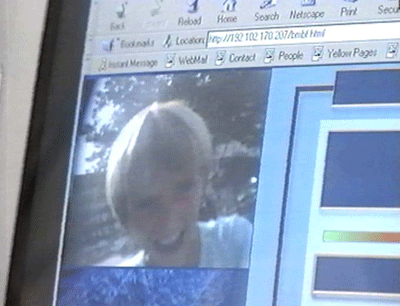
Figure 8 : Dino Hunter scenario — live video stream
[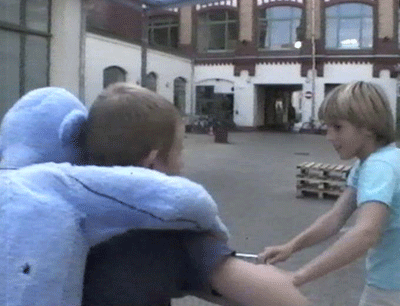
Figure 9 : Dino Hunter scenario — kids on-site search dinosaur fragments
The Dino Hunter scenario can be applied to many other areas, like information technology, life sciences or engineering sciences, and so on. The mentioned subject areas have in common that they are particularly hard to understand (e.g. How does an engine work? How is an organic body built?). Complex information must be understood and learned by the pupils. A possible future gaming and learning scenario could be to collect parts of a car engine, put them together, and make them work in the virtual reality environment.
Acknowledgements
Provided methods and concepts of this paper have been developed in collaboration between the departments of Digital Storytelling and Mobile Information Visualization at the Computer Graphics Center Darmstadt and Fraunhofer Institute for Computer Graphics Rostock.
The Dino Hunter concept has been developed in collaboration between the Digital Storytelling department at Computer Graphics Center and the user interaction specialists ion2s — buero fuer interaction (engl. ion2s — office of interaction).
The trademark "Telebuddy" and a utility model application for the inventions are registered at the German Patent and Trade Mark Office DPMA.
References
Braun, N., J. Dechau, O. Schneider, I. Iurgel, S. Goebel (2002): The Story as Contextual Basis of the Collaborative Group Experience. In Proceedings of the Workshop on Storytelling in Collaborative Virtual Environments, ACM Collaborative Virtual Environments.
Dechau, J., U. Spierling, N. Gerfelder, M. Finke, R. Ide, T. Kirste, (2000). The Telebuddy: Collective Tele-Presence and Tele-Conversation through Physical Avatars. In: Heuer, Andreas (Ed.) u.a., Fraunhofer-Institut für Graphische Datenverarbeitung, Institutsteil Rostock u.a. In Proceedings of the IMC 2000, Intelligent Interactive Assistance & Mobile Multimedia Computing. Rostock: Neuer Hochschulschriftenverlag, 89-98
Dechau, J., M. Finke, N. Gerfelder, N., R.Ide, R., Kirste, U. Spierling, (2001). The Telebuddy: Collective Tele-Presence and Tele-Conversation through Physical Avatars. In: Computers & Graphics 25 , 4, 601-608
Feix, A., A. Hoffmann, K. Osswald, S. Sauer (2003). Dino Hunter - Collaborative Learning Experiences in Museums with Interactive Storytelling and Kids Innovation. Accepted to 1st International Conference on Technologies for Interactive Digital Storytelling and Entertainment, Darmstadt, Germany.
Goebel, S., S. Sauer (2003). Focus your visitors — Kids Innovation. Fundamental changes in Digital Edutainment. Accepted to Museums and the Web 2003, Charlotte, North Carolina.
Laurel, B. (1993). Computers as Theatre. Addison-Wesley, New York, USA.
Preece, J. (2000). Online Communities: designing usability, supporting sociability. New York: John Wiley and Sons.
Preece, J., Y. Rogers, H. Sharp (2002). Interaction Design — Beyond Human-Computer Interaction. New York: John Wiley and Sons.
Short, J., E. Williams, B. Christie (1976). The Social Psychology of Telecommunications. London: John Wiley and Sons.
Spierling, U., J. Dechau (2000). Der Telebuddy — Telekonversation mit einem Physischen Avatar. In Proceedings of 1st Workshop on Digital Storytelling, Computer Graphik Edition Band 2. München: Fraunhofer IRB Verlag, 2000
Spierling, U., R. Ide, J. Dechau, M. Finke (2000). The Telebuddy TM: Tele-Conversation through a Physical Avatar. Essay Computer Graphic Topics, Darmstadt, Nr. 3/2000
Rice, R.E. (1987). Computer-mediated communication and organizational innovations. Journal of Communication, 37, 85-108.
Rice, R.E. (1993). Media appropiateness. Using social presence theory to compare traditional and new organizational media. Human Communication Research, 19 (4), 451-484.
Related Links
Official Telebuddy Web site: http://www.telebuddy.de
Computer Graphics Center ZGDV e.V.: http://www.zgdv.de/zgdv
Fraunhofer IGD Rostock : http://www.rostock.igd.fhg.de/IGD/
Microsoft Actimates: http://www.microsoft.com/hardware/actimates/
Siemens Leonie Project: http://www.siemens.com
